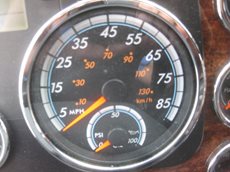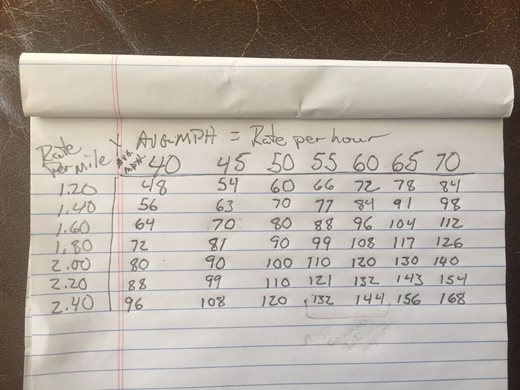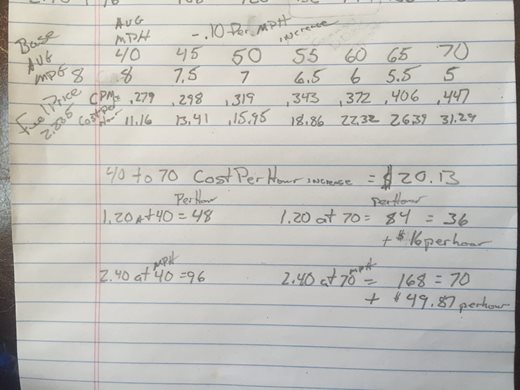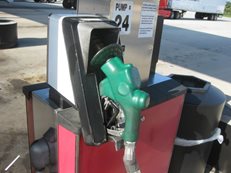 As I stated in my last blog, we can never become complacent when it comes to fuel efficiency. I mentioned how many in the trucking industry have made fuel surcharge into a profit center. With fuel prices on the decline this profit center is drying up like a puddle in the desert. Something that hasn’t changed is that it is important to continue operating at maximum profitability.
As I stated in my last blog, we can never become complacent when it comes to fuel efficiency. I mentioned how many in the trucking industry have made fuel surcharge into a profit center. With fuel prices on the decline this profit center is drying up like a puddle in the desert. Something that hasn’t changed is that it is important to continue operating at maximum profitability.
During the last period of increased fuel prices, many carriers and owner operators sacrificed their time in favor of fuel efficiency by reducing their road speed. The most common speed was between 62-65 mph. I know some owner operators who lowered their top speed to as low as 55 mph. With fuel prices continuing to drop towards $2.00 per gallon, it’s time to evaluate speeds roll in profitability. Keep in mind that increased road speed can only increase income potential if additional revenue generated miles is available. For example, getting a ten hour run finished in nine hours has little benefit if your arrival time will still be one hour after the business closed. Using speed to increase profits needs to be used extremely judicially. In my own experience, I have found that the faster I operate my truck speed, the further away it becomes from my average speed for the day, week, month or year.
For illustration purposes, I will share some figures on speed verses income per hour. Just as in my last blog post, I have worked these numbers out with pencil and paper. For me, actually writing these down helps me to remember the equations and how they affect my business. These numbers are average speeds for all miles driven. I’ve reviewed many engine reports and have seen as low as 7 mph and as high as 63 mph. Keep in mind these figures include traffic jams, truck stop maneuvering and many other factors which affect average speed. It is typical for an over the road truck to have an average speed between 50 and 60 mph for all miles traveled. On the chart provided, I have based the 40 mph truck at 8 mpg and reduced the fuel mileage one tenth of a mpg per each one mile per hour increase in speed.
 |
This made the 40 mph truck at 8 mpg reduce its fuel mileage to 5 mpg at the unrealistic average speed of 70 mph. If we figure on the current national diesel price fuel average of 2.235 at 8 mpg would be a cost of .279 cents per mile. At the .279 cost per mile x the average speed of 40 mph equals a cost per hour of $11.16 per hour. For the 70 mph 5 mpg truck, at the same fuel price the cost per mile would be .447 cents per mile and a cost per hour of $31.29. This would mean an increase cost per hour of $20.13 for increasing the average speed from 40 to 70 mph. If your rate per mile is $1.20 at 40 mph the income to the truck is $48.00 per hour. At a 70 mph average at $1.20 per mile, your income to the truck becomes $84.00 per hour. This is an increase of $36.00 per hour. If we then take out the increased fuel cost per hour of $20.13 the increase income to the truck would be $16.00 per hour.
Moving to the other extreme on the chart, let’s look at a rate of $2.40 cents per mile. At 40 mph the average speed would equal $96.00 per hour to the truck. At 70 mph this increases the rate per hour to the truck to $168.00. This is an increase of $70.00 per hour. After taking out the same $20.13 increase in fuel cost, we are left with an increase of $40.87 per hour.
 |
Items to keep in mind are fuel economy decreases on a bell curve with each mph costing more for each additional mph. Also, as the truck/trailer combination becomes more aerodynamic the bell curve becomes less extreme. Basically a 5 mph increase on a classic truck/trailer combination has a far greater impact on fuel consumption as compared to today’s more efficient designs. It’s also important to remember as fuel consumption increases, maintenance cost increase as well. This is why your vehicle speed should be chosen very carefully on an hourly/daily basis. What I have learned during the high fuel price era was more often than not, the productivity gains from increased speed did not increase the  number of revenue miles completed per week. Increased speed will only make you more money if it leads to additional revenue miles. Be careful when figuring out what works for your operation as lower fuel prices do not necessarily mean that it’s a good time to quit worrying about fuel efficiency.
number of revenue miles completed per week. Increased speed will only make you more money if it leads to additional revenue miles. Be careful when figuring out what works for your operation as lower fuel prices do not necessarily mean that it’s a good time to quit worrying about fuel efficiency.